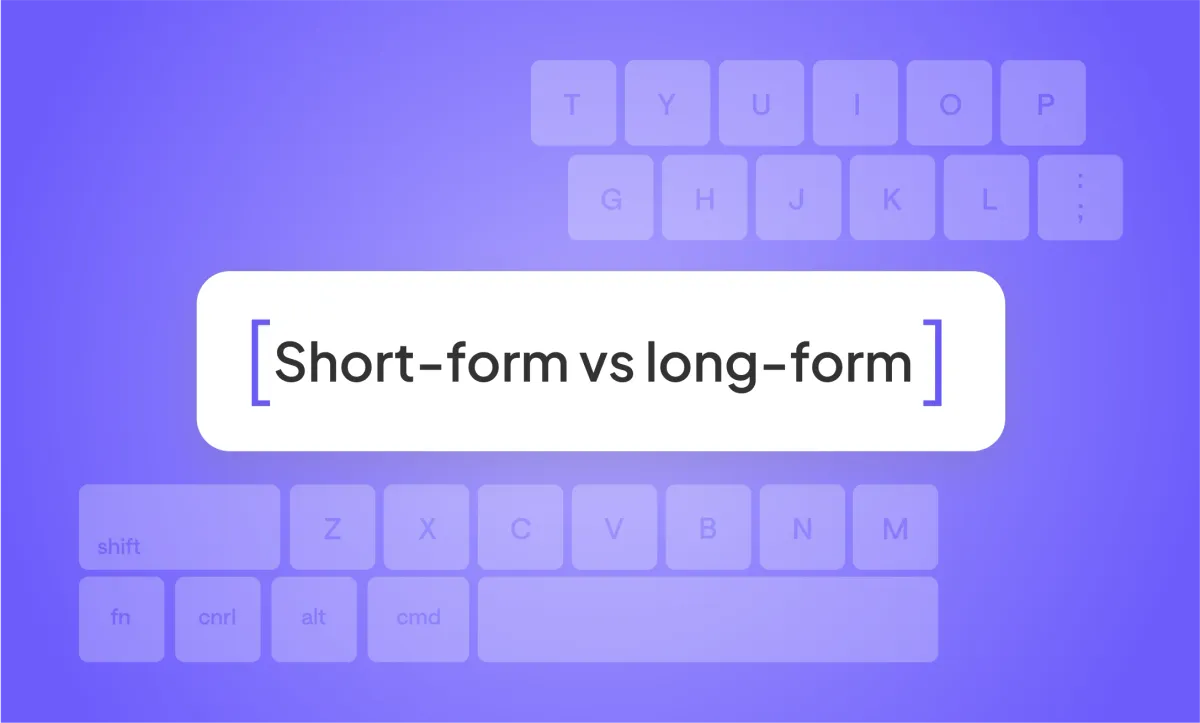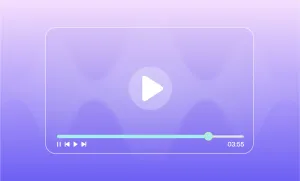Winning over consumer's attention nowadays requires spending considerable resources. People are constantly bombarded with information, which can make it seem like they’re rapidly losing their ability to focus. However, recent findings suggest that attention spans are more context-dependent than previously thought.
While Gen Z might prefer short-form content on platforms like TikTok, they also engage deeply with longer, in-depth videos when the topic resonates with them. In fact, Google reports that 85% of Gen Z uses short-form apps to discover content, but they stick around for long-form deep dives when interested. This means that, instead of simply shrinking, attention is shifting — and the challenge becomes finding ways to capture and sustain it.
So, how do you capture the attention of your target audience in such conditions? Create videos. They're quick, engaging, and get right to the point. But here's the big question: short-form vs. long-form video content? Should you go for a 30-second TikTok or a long-form, 10-minute YouTube video with in-depth information?
Top creators use different video lengths across various marketing channels. In this blog post, we'll walk you through the peculiarities of these video content formats, educate you on how to maximize the potential of your content marketing strategy and show examples of renowned creators.
Short-Form vs. Long-Form Video Content: Definitions and Evolution
First things first, let's define the two video formats under discussion:
1) Short-form video content
Creators decide on what they call short-form videos and long-form videos themselves. Some may consider clips more than 1 minute to be long videos. However, in most cases, short-form videos are those that last 5–90 seconds or are under 10 minutes. They're typical of social media platforms like TikTok, Instagram (Reels), and YouTube (Shorts).
2) Long-form video content
Long-form videos exceed 10 minutes and are widespread on YouTube, Instagram (IGTV), and corporate websites like those on a homepage and landing or product pages.
Brief History
How did it all start? Well, back in 2005, YouTube was just a video dating site. But suddenly, it has grown into a major video search engine, offering creators the ability to upload content of various sizes, predominantly longer videos.
With the emergence of TikTok, viewers switched to quick, snappy clips. You may have noticed that such short videos may retain your attention much stronger than long-form videos. Having observed this tendency, other social media platforms like Instagram and YouTube have also added features for short-form videos (Reels and YouTube Shorts, respectively).
Why have shorter videos gained much traction? The reason is that they provide instant gratification, sending positive signals to our brains. Watching them is similar to the dopamine release happening when we encounter something pleasurable or rewarding (a quick laugh or learning something new in the case of consuming short-form videos).
Today, content creators leverage both short and long-form video content to maximize the impact of their digital marketing approach. That's why, if you want to get as many followers as possible, your video content strategy should be flexible.
Pros and Cons of Short-Form vs. Long-Form Videos
Selecting a format that is worth the cost can be challenging because both forms of video content have benefits and drawbacks.
Short-form video content offers high engagement rates, shareability, and ease of production. It's ideal for quick consumption, social media trends, and tips. All you need to shoot such clips is to tap a "Start Recording" button on a smartphone, and you may not need to partner with a video production company.
On the downside, you have limited timeframes. You can't tell a story as deeply as you'd like to or address the main audience's pain points thoroughly.
What about longer videos? Long-form video content comes with greater storytelling potential, more profound audience connection opportunities, and more monetization options. For example, long-form YouTube videos allow you to elaborate on topics in more detail or tell a compelling story while inserting an ad at some point. Having such videos on a website can improve search engine rankings as people will spend more time on a page. Google likes this.
However, long videos imply higher production costs. Video editing takes much more time and often calls for the professional services of a video production company or an in-house team. Fortunately, in many cases, long-form video content creators can also rely on AI-powered content creation platforms like Podcastle to streamline the entire editing process and cut down on costs:
Use Case Examples
Why limit yourself to one video format when you can leverage the strengths of both? That's what some content creators also propagate in their video marketing strategy. For example, MrBeast, an American YouTuber, produces videos that are up to 40 minutes long and Shorts. Both types of content garner more than 200 million views.
Emma Chamberlain follows the suit. While she's primarily a YouTuber, she also runs an Instagram account and publishes short-form videos. Moreover, Chamberlain signed a contract as a Lancome brand ambassador in January 2023. Her appearances on Lancome's YouTube channel include a web series; shorter versions of the series are also available on Instagram and TikTok.
Strategies for Success in Both Short-Form and Long-Form Content
What should you know before recording any video or planning your video strategy? Let's review the process step-by-step and share some content ideas for your high-quality videos.
1) Understand Audience Preferences
Don't rush into creating videos without understanding your audience's preferences first. Viewers may want different video styles, so you need to collect valuable insights into their behavior and expectations. That's where tools like Google Analytics and platform-specific features may help.
YouTube, TikTok, Meta, and others offer analytics capabilities, showing what videos engage viewers quickly. Plus, keep in mind the platform's distinguishing features. TikTok, for example, isn't the best place for long-form videos. Tailor the video length and style to match each social media. Also, leverage polls and surveys to ask users directly about their likes and dislikes.
2) Mind Content Planning and Storytelling
Next, craft a content calendar and specify what each format should focus on, namely:
Short-form video zeroes in on quick hooks, trends, and value-packed messages.
Long-form strategies involve storytelling arcs, in-depth exploration, and audience engagement (e.g., Q&A, behind-the-scenes content, interviews, or even mini-documentaries).
The best length for TikTok video content is between 15-30 seconds, which is the best length for Instagram Reels as well. Use vertical video formats and create content that grabs attention within the first few seconds, such as teasers or highlights. The goal is to make the viewer curious and encourage them to take the desired action.
As far as the long-form video option is concerned, dive into detailed explanations, be it a 20-minute YouTube tutorial or IGTV episode. There is no specific estimate of the best length for YouTube videos. The optimal length varies between 10-20 minutes.
Create a content calendar that mixes both short-form and long-form videos. Align it with your brand message and audience habits. Plan brief videos for quick engagement and longer videos for deeper exploration. This balance ensures you cater to different viewing preferences while maintaining a cohesive video marketing strategy.
3) Conduct Platform-Specific Optimization
Every platform has its own rules. For short-form video content, optimizing for each platform is crucial. On TikTok, capitalize on trends, hashtags, and challenges. Instagram Reels require eye-catching thumbnails, engaging captions, and the use of vertical videos.
For long-form content, especially on YouTube, search engine optimization (SEO) is key. Use chapters, detailed metadata, and engaging titles to improve discoverability. Incorporate interactive elements like polls, cards, and end screens to keep the audience engaged throughout the video. If you leverage IGTV for episodic content, maintain a consistent style to build audience anticipation.
To supercharge performance, consider optimizing content with an eCommerce CRO agency. It can be helpful to use the advice of professionals and analyze their vision for improving your content impact and conversion rates.
Choose platforms that align with your content marketing goals. Are you pursuing wider reach and quick engagement? Prioritize TikTok and Instagram Reels. Do you want to pose yourself as an authority leader? Manage a YouTube channel.
4) Repurpose Video Content Between Formats
Ensuring a longer content lifespan is essential. To make sure it stays relevant and fits diverse needs, you need to repurpose existing videos. For example, break down substantial videos into bite-sized pieces for Shorts, Reels, or TikTok. Such short-form videos offer viewers quick value and spur their interest, which can be beneficial for educational channels, SaaS companies, and others.
The same rules apply to a short-form video. You can expand it into a longer-form piece. For instance, a viral TikTok trend can inspire you to create a more in-depth YouTube vlog. Use short-form content as hooks to drive audiences to longer, more comprehensive content. And don't forget about consistency in brand voice across both short-form and long-form video content. Design a cohesive journey across your videos so that users can comprehend the channel and the videos they're viewing right now.
5) Seek Monetization and Brand-Building Opportunities
Investing substantial resources should pay off, right? That's why you need to consider how to not only increase brand awareness but also monetize your social media marketing and videos in particular. Both video formats offer monetization potential. However, there are some differences:
The monetization of short-form videos: brand partnerships, sponsored content, and social media platform programs.
The monetization of long-form videos: ad breaks, Patreon support, channel memberships, and brand sponsorships.
Combining these formats allows you to build a comprehensive brand image and use all touchpoints possible to your advantage.
6) Test and Iterate
Once videos are live, don't stick to the rigid rules regarding content lengths and formats. Experiment with different digital marketing strategies to reach the best video performance possible. Analyze metrics and answer questions like what video length draws in more viewers and whether people drop off while watching more extended materials.
Use data analytics to refine strategy and iterate until you crack the algorithms. Be flexible to respond to new trends and expectations, yet stay true to yourself.
Final Thoughts
As you can see, in today's world and the abundance of social media, you don't have to and shouldn't choose sides. Instead, it's more efficient to embrace both long-form and short-form video content for a successful video marketing strategy.
We've identified that each format has its strengths, be it rapid engagement and virality or deeper storytelling and connections. No matter what you pick for content creation, the key is to stay adaptable, repurpose materials, and respond to audience needs. Leverage both formats, boost engagement, and augment your content marketing.
About the Author: Kate Parish

|
Kate Parish is a chief marketing officer at Onilab. She has almost a decade of experience in the company and is still enthusiastic about every aspect of digital marketing. Kate sees the marketing mission in ensuring sustainable business growth. For this purpose, she helps companies and readers create efficient campaigns, solve common problems, and enhance crucial website metrics, such as conversions, bounce rates, and others. |








